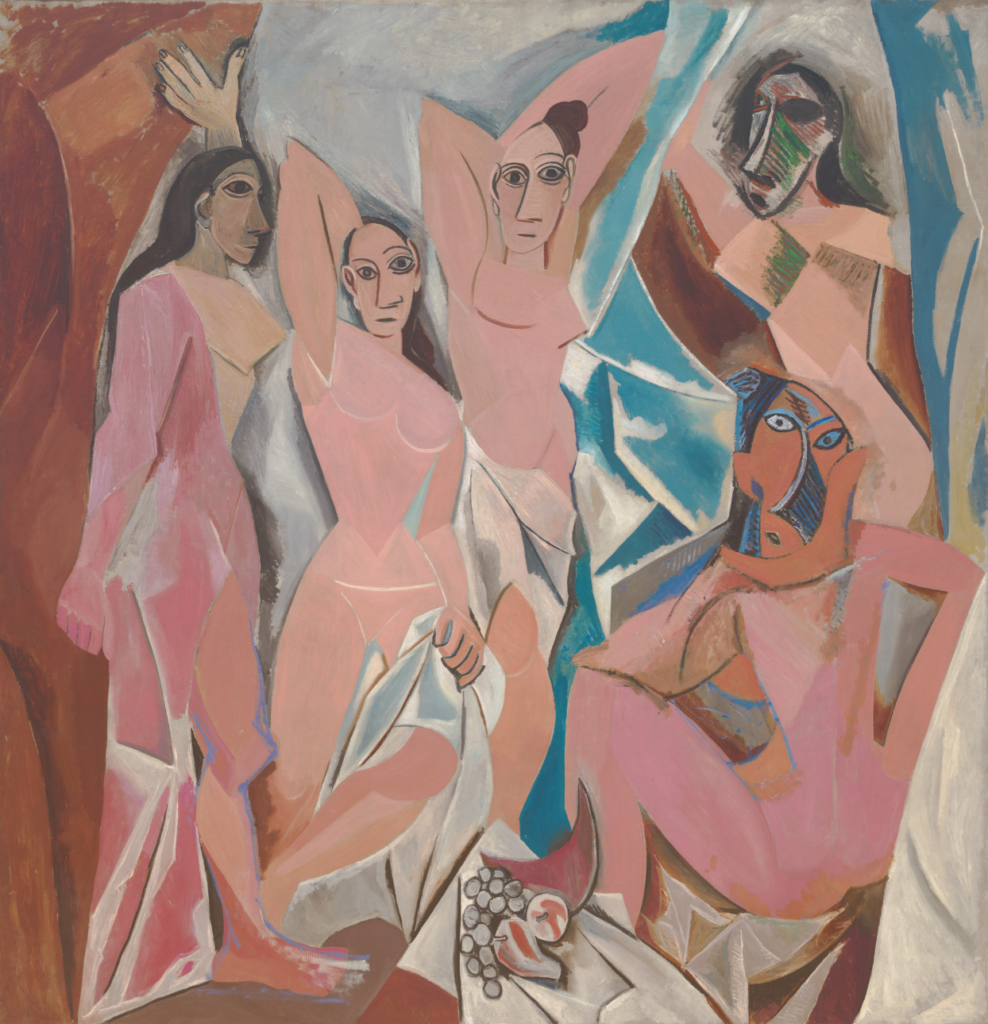Les Demoiselles d’Avignon, 1907
Five women glare at us, but their faces look like carved masks and their bodies snap into knife-sharp angles. Picasso smashes the calm, soft nude he learned in art class and turns it into a puzzle of hard planes. The painting feels fast and risky, like Paris racing into the new century. Here the body becomes a warning: forget old rules—modern life is wild and jagged.
Oil on canvas. The Museum of Modern Art.
8′ x 7′ 8″ (243.9 x 233.7 cm)

Guitar, 1914
This isn’t a solid statue; it’s thin metal sheets bent into the shape of a guitar and hung on the wall. Open holes stand in for real volume, so air is part of the sculpture. Think of it as a human torso rebuilt from factory scraps—perfect timing for a world rushing toward World War I and steel machines. Picasso shows that a “figure” can be just parts and empty space.
Painted sheet iron and wire. The Museum of Modern Art.
30 1/2 x 13 3/4 x 7 5/8″ (77.5 x 35 x 19.3 cm)

Three Musicians, 1921
Bright blues, reds, and yellows fill a huge canvas that feels like a paper-cut collage. Three masked players crowd together on a stage, their instruments doubling as their bodies. After the war, Picasso glues shapes instead of breaking them, but identity is still shaky: masks hide real faces. The piece says people in the roaring ’20s could swap roles as easily as changing clothes.
Oil on canvas. The Museum of Modern Art.
6′ 7″ x 7′ 3 3/4″ (200.7 x 222.9 cm)

Girl before a Mirror, 1932
A young woman peers at her reflection, but the mirror shows a stranger—green skin, swollen curves, dark eyes. The bright side and the spooky side push against each other, like day arguing with night. Picasso dives into Surrealism here, turning the body into a battle between how we look and how we feel. It fits the 1930s mood of doubt during the Great Depression.
Oil on canvas. The Museum of Modern Art.
64 x 51 1/4″ (162.3 x 130.2 cm)

Night Fishing at Antibes, 1939
Neon pinks and greens light up a tense night scene on the dock. Figures twist at weird angles while a huge fish lurks in inky water. Painted just before World War II, the canvas feels nervous, like everyone senses danger beyond the dark horizon. The bodies stretch and strain, matching the stress in the air.
Oil on canvas. The Museum of Modern Art.
6′ 9″ x 11′ 4″ (205.8 x 345.4 cm)

Woman Dressing Her Hair, 1940
Thick black lines bend a woman’s arms and spine into almost machine-like parts. Her face is more mask than flesh. Picasso painted this in Nazi-occupied Paris, and you can feel the squeeze of fear: even a private moment looks tense. The figure shows how war pressure twists everyday life.
Oil on canvas. The Museum of Modern Art.
51 1/4 x 38 1/4″ (130.1 x 97.1 cm)

The Charnel House, 1944-45
Gray, black, and white bodies tangle on a kitchen table, limbs crossing until it’s hard to see where one person ends. Picasso used charcoal over wet paint, so lines scratch like bad news on a radio. Made after hearing about civilian massacres, the piece turns the human form into evidence of war horror. The body isn’t heroic; it’s broken and stacked like wreckage.
Oil and charcoal on canvas. The Museum of Modern Art.
6′ 6 5/8″ x 8′ 2 1/2″ (199.8 x 250.1 cm)

Studio (La Californie), 1956
Sunlight floods Picasso’s bright studio. Canvases, sculptures, and even the painter’s easel crowd together, nearly breathing. After years of dark war scenes, color blasts back—yellows, blues, hot reds. The studio itself feels alive, and the bodies inside are playful, not panicked. Picasso shows he’s still reinventing the figure, now with energy and hope.
Oil on canvas. The Museum of Modern Art.



